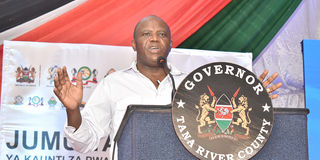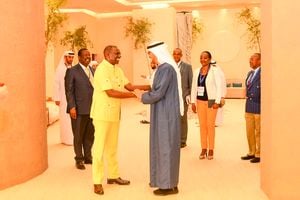Urbanising Tana River County: The impact of devolution
Sponsored by County Government of Tana River

Tana River Governor Dhadho Godhana speaking during the 4th Jumuiya Agribusiness and Blue Economy Investment Conference at Hola Stadium, Tana River, on December 7, 2022.
By Stephen Oduor
In the 10 years that Tana River County has governed itself since the advent of devolution in Kenya, it has undergone an outstanding transformation. The scale of its growth and the sheer speed of change draws a clear distinction between what it used to be before devolution, and now.
A once impoverished, marginalised, and underdeveloped region is fast urbanising and transforming into productive agricultural, fisheries, and tourism economy, under the leadership of Major (Rtd) Governor Dhadho Godhana.
The former military man, once a Member of Parliament with a reputation for pragmatism, adopted a transformative development model that would inspire urbanisation to trigger investments and stir up economic activity, create jobs, and fight poverty.
“There was no elaborate blueprint for development in the county by the time I took over. Our people were still riding on a rollercoaster of the decades-old miseries, and according to me, urbanisation was the solution to it all,” says the governor.
Just 10 years ago in 2013, Tana River County was marked with dusty roads, darkness, and a cloud of hopelessness that bred poverty in all its flanks. People struggled to earn a living, as all the 15 minor irrigation schemes they relied on had collapsed. Adverse effects of climate change orchestrated by tree felling for charcoal burning ushered in hotter weather, drought, and famine, which all struck in one accord.
The region’s poverty index was at its record high of 79 percent, as per data by the Kenya National Bureau of Statistics.
“The first thing I thought we could do to mitigate losses was to develop eco-villages in the uplands, where we would relocate everyone living downstream to, and then the places they had known as home become their improved farms,” narrates Governor Godhana.
With a population of more than 370,000, an estimated 100,000 people get affected whenever a climatic calamity such as floods, hits. This reduces the economic stability of each household by more than 60 percent, creating at least 2000 fresh households of people living below a dollar a day.
This is brought about by the loss of businesses, crops, livestock, and lives, and the emergence of diseases that require treatment at a cost.
The recovery after every calamity has never been absolute, and has been taking a chunk of the county’s resources estimated to be more than Ksh300 million, hence the eco-villages plan by the county government under Godhana.
The eco-villages seek to resettle more than 60,000 people from flood-prone areas to modern village clusters that will comprise a well-planned food production area, a place set aside for industrial development and modern housing.
“This is a human-scale full-featured settlement in which human activities are harmlessly integrated in a way that is supportive of healthy human development,” the Governor says. He notes that the goal of the eco-villages programme is to eradicate poverty, restore the natural environment, and ensure the integration of all basic human needs.
The initiative, he says, will inspire the use of locally sourced materials, create green buildings, rely on sustainable infrastructure and technology, and focus on restoring and protecting the natural environment.
Three pilot clusters have advanced the process in a partnership between the administration and Habitat for Humanity Kenya. The collaboration will see the construction of 15 low-cost houses as the administration seeks funding to make the first 14 eco-villages a reality.
“This is a project that aligns with the government’s housing idea. It is costly and hence our budget cannot sustain it. That is why we seek and welcome other stakeholders to take part in this great idea,” says Governor Godhana.
The Handampia Cluster and Baomo have so far made strides as their blueprint has been finalised, and partners are forwarding proposals for various ideas to be implemented.
This is just part of the story of Tana River’s transformation since the region started governing itself in 2013. For more stories on how the county is performing in different sectors, click here.


